Mary Geary: The Market gardeners’ daughter.
On my 15 July 2024 story I introduced my Neville line and the fascination it has held for me for many years.[1] Now I aim to write about the child of the last Neville in my direct line, that is my 2 x great-grandmother Mary Geary, who I briefly mentioned in my blog of 7 April this year. As genealogists we struggle to find information about the women in our families and it is much the same for Mary Neville and her daughter, Mary Geary.
The first girl born to James and Mary Geary (ms Neville) was named after her mother and baptised on 2 May 1824 at Holy Trinity, Twickenham, Middlesex.[2] By 17 years old in 1841 she was living away from home with her cousins in the Town Square, Isleworth and within six years she had met her husband-to-be, Henry White.[3]
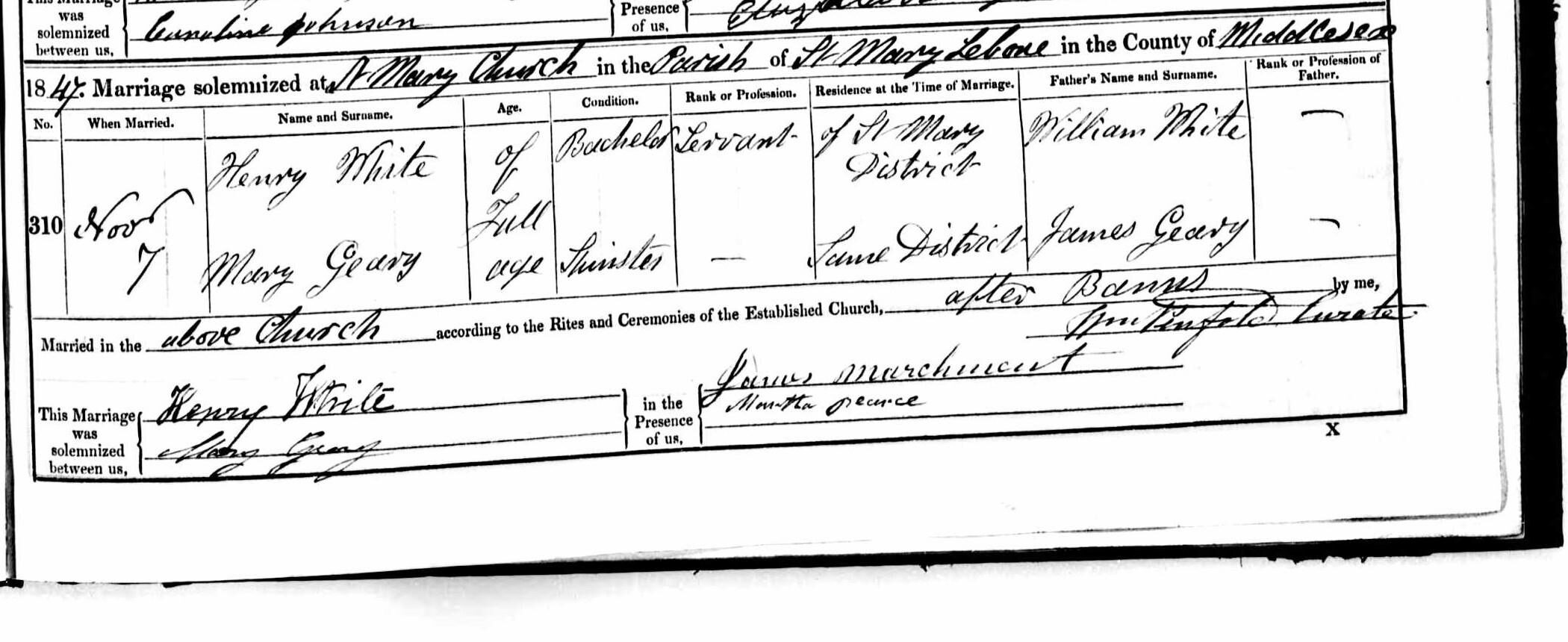
Marriage of Henry to Mary Geary on 7 November 1847 at St Mary Church, Parish of St Marylebone.
Henry and Mary were married on 7 Nov 1847 in St. Marys Church, Parish of St. Marylebone, in central London. At the time of the marriage, Henry was a bachelor and his occupation that of a servant with his residence shown as ‘of St. Mary’s District’ as was Mary Geary’s. Mary is not listed as having an occupation, her father is shown as James Geary, and Henry Whites father as William White. No rank or profession of either father was listed but both the bride and groom were able to sign their names.
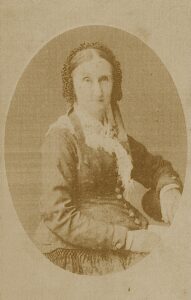
Mary White. Portrait taken abt 1890
Henry and Mary had their first child, Henry while living at Isleworth in 1848, Arthur was born at Poplar in 1850, Lucy at Poplar in 1852 and George at Limehouse in 1857. Poplar and Limehouse are inner London suburbs.
In 1857 the family emigrated to Sydney from England arriving on 4 October 1857 on the ship ‘Light of the Age’ as assisted immigrants. This was a large wooden Clipper ship of 1287 tons of Marshall & Eldridge.[4]&[5] On the shipping records Henry is shown as being a ‘Rough Carpenter’ 33 years old and Mary 32 yrs with their four children. The shipping records confirm that Mary’s parents are listed as James and Mary Geary residing at Twickenham.
Following their arrival in the Colony the family spent some time in the Campbelltown area where their next child, Elizabeth Ann White was born in 1859. The call of gold then beckoned Henry, as Rhoda was born at Braidwood in 1861. About this time it took 3 months by bullock team to go from Sydney to the Braidwood goldfields, as there were no inland roads, and many floods along the way. Most miners travelled by ship to Broulee then to Braidwood by walking overland, crossing the Due River and Araluen Creek some 30 to 40 times on the journey.
Two years later the family had headed east closer to the coast as in 1863 my great-grandfather William, was born on the goldfield at Nerrigundah and his birh registered at the coastal town of Broulee. The birth certificate confirmed that Henry and Mary had three sons and three daughters living at the time of Williams’ birth. Having decided to try his luck at Araluen the family once again travelled west over the ranges. Mary was to have two more children there, Charles in 1865 and Alice Mary in 1871. Those births were registered at Braidwood.
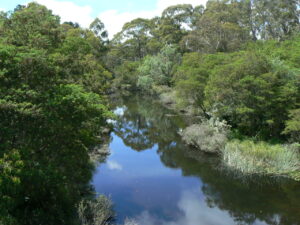
Mongarlowe River looking south from the bridge. Photo by Author in 2011.
Mary was 47 yrs old by this time, and she had borne nine children who now ran in ages from the 23 yrs old Henry to the newborn Alice. What was going through Mary’s mind by then with the constant changes in location? It seems likely that the majority of her life on the goldfields would have been spent in a tent with very basic facilities. It is somewhat of a surprise then to read of her son’s description of her in his lengthy story titled ‘My Home Life in Early Days’. Luckily for me, William was quite a prolific writer throughout his life.
‘My mother was a frail and tender woman, and on account of the fact that she was not strong and there were six other children to care for, I was mainly given over to the elder members of the family to rear to a large extent according to their ideas’.
William later went on to describe how by this time Henry had left the family, presumably in Araluen, to prospect the other side of Braidwood where he discovered enough gold to be able to send for his family after buying a cottage and land in Little River which is today known as Mongarlowe, just east of Braidwood. Henry named his property ‘Rosedale’ and it was on the outskirts of the village area.
No doubt Henry had gained a sound knowledge of growing produce during his days in London visiting his father-in-law, James Geary a market gardener, as on Rosedale he established an orchard with many fine English fruit trees. It would seem likely that his father-in-law might have shipped the original plant-stock out from his selection.
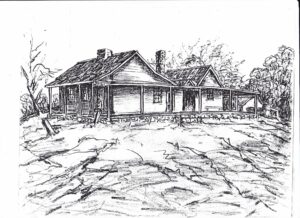
Rosedale, the White family farmhouse at Mongarlowe. From Braidwood Historical Society thanks to Grant Taylor for passing this image onto me.
‘Around the dear old home was a fine orchard which grew prolifically all English climate fruits. We had glorious apples, cherries, gooseberries, raspberries, plums and the other products of a cool climate. The farm was situated at the foot of a beautiful mountain which rose to the east, and over which we daily saw the sun slowly peep. One portion of this mountain range just slightly north-east of our home, which had a most commanding view of the mountains, contained many huge rocks, and in the winter it presented a most glorious picture often crowned with a mantle of snow.[6] The view was at perfection when the setting sun cast his last feeble rays on this snow clad mountain and left an impression that one never forgot.
The family soon settled down in their new home. There was plenty of work to be done, and as they were rather new chums at farm life, they were at first rather awkward in the performance of what required to be undertaken. They speedily adapted themselves to the new conditions, and in a very short space of time became quite familiar with the new methods of working and how to perform them. My brothers soon became versed in the handling of horses, milking of cows, ploughing, and the other essential work to be undertaken on a farm’.
From other family stories and letters, I know that the couple kept in close contact with their English families. Mary obviously knew she had a cousin in Melbourne, as William wrote about another incident:
‘Time passes slowly at times on the farm. We were all growing up, and as things were very dull Dad wrote to some of our relatives in Victoria. It ended in a visit from one of our cousins.’
Mary’s son, William collected his cousin, although he did not notate the cousin’s name in his story. However, I now know who this cousin was from clues within the story; it was Mary’s cousin, Anne Terry Neville’s son James Carter born 1858 in Victoria. William was sent by horse to meet the mail coach at Braidwood, a journey of 9 miles and collect his cousin.[7]
‘There was great excitement when we arrived home. Dad gave our cousin a hearty welcome and introduced him to all members of the family. He very soon settled down to our conditions of life and made himself very agreeable to us all. He was a host in himself, and no doubt his profession (Lawyer’s clerk) fitted him for any company. He could spin a good story, played a brass instrument, and in a word was a very nice genial fellow and excellent company’. The story went on to describe William’s teenage sisters vying for young James’ attention, then ‘ My charming cousin stayed with us for about 3 months and then decided to go back to the old “Cabbage Garden” as Victoria was called’.
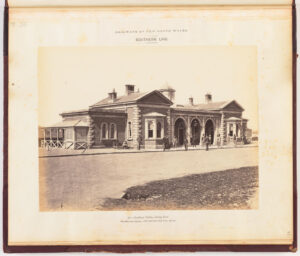
Goulburn Station looking east with staff and passengers standing for a portrait.
‘Amidst many sobs my cousin left the old farm. This was my first visit to the town of Goulburn, and I was naturally very anxious to see it and also to see the railway. In those days toll gates were stationed on all the main roads, and all who went through with horses and conveyances had to pay. We made the journey very slowly, and had to camp out two nights’.
It is a lengthy document, and I am grateful to have been given the opportunity to translate it by my father’s cousin. Except for one son and one daughter living in the region, the children grew up and left the area, mainly to move to employment in Sydney. The old couple remained on the farm, with both Henry and Mary White surviving into the next century. Henry, 83 passed away on 24 February 1906 and Mary, 84 dying on 17 June 1908. Both were buried in the Mongarlowe Presbyterian cemetery although sadly, no tombstone exists.
[1] https://gsq-blog.gsq.org.au/the-neville-family-myth-false-true-or-maybe/
[2] London Metropolitan Archives. Film X100/222 Twickenham Parish, Middlesex. Bishops Transcripts film. Ref Dl/Dro/Bt/068/016. Entry 1398 page 175. Viewed Oct 2007.
[3] https://gsq-blog.gsq.org.au/henry-white-from-bletchingley-servant-to-mongarlowe-orchardist/
[4] Log of Logs Volume 2.
[5] https://environment.gov.au/shipwreck/public/wreck/wreck.do?key=6362
[6] Now part of the Budawang National Park
[7] William White and James Carter were second cousins.

Comments
Mary Geary: The Market gardeners’ daughter. — No Comments
HTML tags allowed in your comment: <a href="" title=""> <abbr title=""> <acronym title=""> <b> <blockquote cite=""> <cite> <code> <del datetime=""> <em> <i> <q cite=""> <s> <strike> <strong>